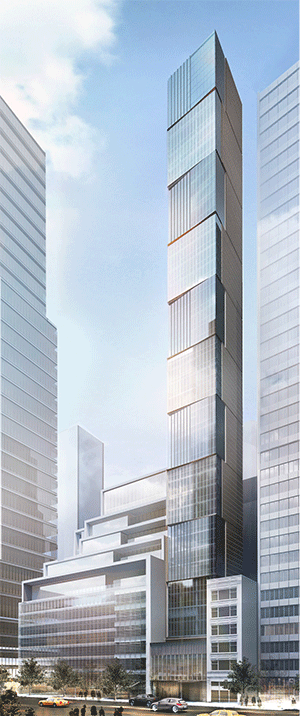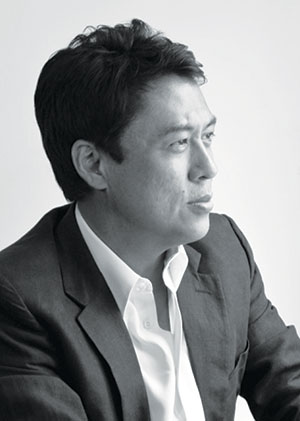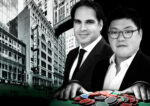Trending
Flat, not crowded and very hot on 59th Street
Soo Chan’s latest synthesizes design ideas on the edge of Midtown

The little stretch of Manhattan along 59th Street from Park to Lexington is covered in scaffolding from three distinct projects.
Two of these involve the recladding or restoring existing buildings. But one has to do with the actual construction of a building, a new high-rise that will soon occupy 118 East 59th Street.
The undistinguished four-story building that stood on that site, home to a former tuxedo shop, is demolished and construction is set to begin. Brown Harris Stevens Development Marketing will begin selling the units in September.
The 38-story building will rise on the south side of 59th between Park and Lexington Avenues. The development has been in the news: The Times reported that this project, developed by Euro Properties, represents the first entirely Chinese real estate development in the city (as opposed to partnerships between Chinese and local firms). It also is one of the most important new developments, certainly residential developments, to arise on East 59th Street, at that crucial juncture where Midtown turns into the Upper East Side.
The new building is designed by Singapore-based SCDA Architects. This is the second time in less than a year that this firm has made a potent claim upon our attention, the first being the distinguished design for 515 Highline, a residential tower on West 29th Street.
Of late, the work of SCDA Architects, led by Soo K. Chan, has borne a certain resemblance to that of such contemporary Japanese architects as Fumihiko Maki, Yoshio Taniguchi and Tadao Ando, all of whom have built or are about to build in New York City. The style that seems to dominate his work and theirs is that of a pared-down modernism, strictly rectilinear and very pure.
The new building will contain 29 units and all of them will be full-floor properties. Some of the higher ones promise views of Central Park. The remaining floors will serve as common areas, including a private dining and catering facility, a fitness center and spa, and a lounge with outdoor gardens. Because of the narrowness of the site, which is only a little wider than a townhouse, the street-level area will have space only for the lobby, rather than for any commercial use.
There is a certain metallic modernism to Chan’s aesthetic in designing the building, especially at street level and on the floor above it. Its attractive entrance consists of a strong, cantilevered canopy that juts out over the sidewalk — positively shrieking “residentiality” in the commercial district — even as the entranceway recedes sharply back into the building. In both of these energetic, almost Baroque movements, the architect is playing off the emphatic flatness of the rest of the entrance, which clicks into place so as to seem flush along the street line. At this level, there is also a rich interplay of segmented lines: mostly vertical, but also horizontal at points. The lobby to the left of the entrance is visible from the street through a single giant and indivisible pane of glass. But on the second floor, the glass has been applied in a curtain wall of a dozen or so thin strips, topped by a metallic passage of minutely serried groves that look as though they are concealing some mechanical core.

Soo K. Chan
Interesting things happen to the building as it progresses beyond that point. The structure as a whole recedes from the street line in a setback that continues all the way to the top. But it is not a flat-curtain wall at this point, but rather a sequence of alternating switches that alternately recede or protrude to the right or left. Each of these switches is four stories tall, and there are nine of them in all. At the summit, order is restored as a two-story curtain wall, parallel to the street line, signals the end of this constantly, restlessly shifting movement.
Several local precedents for this design motif come to mind. Perhaps the most relevant is the Switch Building, at 109 Norfolk Street on the Lower East Side, which was completed in 2008 to designs by Eric Bunge and Mimi Hoang. At the same time, the sequencing of passages or blocks of floors up the entire length of the façade brings to mind One Madison, designed by Cetra/Ruddy, on West 23th Street. But it may be that the most powerful precedent is the as-yet unbuilt 80 South Street, whose fine design was the work of Santiago Calatrava, before it fell victim to the economic downturn. There, what look like a series of cubes, one atop the other, were supposed to rise over a thousand feet into the sky.
Chan appears to have learned from all of these precedents. Like so many other architects in New York these days, he is clearly striving to make his mark with a distinctive and innovative structure. And 118 East 59 Street will indeed stand out and draw attention to itself. But it will do so as much through the general pallidness of its neighbors as through its own daring design. It is very much a grown-up building, unlike the Switch Building or its southern neighbor Blue, designed by Bernard Tschumi, which have an almost impish recklessness to them. On 59th Street, by contrast, Chan never looses control and the result is a stately, refined, competent and expensive product.
It is notable that 118 East 59th Street, on the outskirts of Midtown, is set to rise in an area that has not traditionally been seen as ripe for residential development. But now, with the condo-mania that has overtaken Manhattan in the past decade or so, there is no part of the city that is not ripe for new residential architecture, and that is just as true of East 59th Street as of anywhere else. What is perhaps more striking is that this new development is not being marketed — as might have been the case in the past — as occupying the southern edge of the Upper East Side, but rather as standing in enviable proximity to “Billionaires Row” (which is to say 57th Street) and specifically to 432 Park Avenue, which is around the corner and two blocks down.
Surely the Upper East Side is still a repository of old-world charm, and an enduring destination, indeed, the center of one’s homing, for all those buyers in search of a certain gentility and burnished tradition. But with so many areas of the city, and especially of Manhattan, being redefined as residential zones, the once venerable neighborhood no longer has the caché it once had.
That said, it may be that 118 East 59th Street, when completed, will seem to be a worthy enhancement of both Midtown and the Upper East Side.




